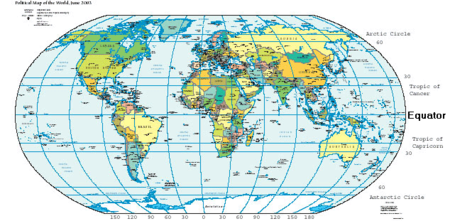Equator
|
|
The equator is an imaginary line drawn around a planet, halfway between the poles. The equator divides the surface into the Northern Hemisphere and the Southern Hemisphere. The latitude of the equator is 0 by definition. The length of Earth's equator is about 40,070 km, or 24,898 miles.
Earth's equator
On the equator, the Sun is directly overhead at noon on the days of the equinox. On the Earth, every day is close to 24 hours long. At night, all stars appear to trace out a half circle centered at the southernmost or northernmost point of the horizon.
Between the March and September equinox, the Earth's northern latitudes are inclined towards the Sun up to a point known as the Tropic of Cancer, the most northerly point where the Sun can be directly overhead. The most southerly equivalent is named the Tropic of Capricorn.
Seasons in the tropics and at the equator differ significantly from seasons in the temperate or polar zones. In many tropical regions people identify two seasons, wet and dry, but most places very close to the equator are wet throughout the year, although seasons can vary depending on a variety of factors including elevation and proximity to an ocean.
Some climatologists define the climate of a place as equatorial, rather than merely tropical, if the difference between the normal mean temperatures of the warmest and coldest months is -5 ?C or less; climatologist Vladimir K?n originally set a yearly temperature range of 5 ?C (9 ?F) for equatorial climates and placed the letter i after the applicable two-letter classification (Af, Am, Aw or As) for those climates meeting this standard, the threshold of which was later changed to 3 ?C, in part to make the "equatorial" and "tropical" areas more equal in terms of territory covered. If a place does not qualify for the letter i, no third letter is added to its climate designation.
In addition to having a narrower range of annual temperatures than at the outer margins of the tropics, what seasonal thermal differences do exist very close to the equator do not necessarily "follow the sun"—that is to say, the warmest month will not necessarily occur at the time of highest sun and longest days, and the "coldest" month need not be at the time of lowest sun and shortest days. Often, the wettest time of year will be coolest, due to its having more cloud cover and hence receiving less direct sunlight (temperatures at higher latitudes within the tropics, by contrast, do rise and fall in concert with the astronomical seasons). Locations near the equator are good sites for potential spaceports or space elevators, as they are already moving faster than any other point on the Earth due to the Earth's rotation, and the added velocity reduces the amount of fuel needed to launch spacecraft. (See Kourou for an example).
The surface of the Earth at the equator is mainly ocean. Places crossed by the equator:
- São Tomé and Príncipe - passing through Ilhéu das Rolas, an islet in this archipelago
- Gabon
- Republic of the Congo
- Democratic Republic of Congo
- Uganda
- Kenya
- Somalia
- Maldives - may miss every island
- Pini - a small island near Sumatra
- Sumatra
- Lingga and one other small island near Sumatra
- Borneo - Kalimantan
- Sulawesi
- Halmahera
- small islands east of Halmahera
- Gilbert Islands - may miss every island
- Phoenix Islands - near miss of Baker Island
- Line Islands - near miss of Jarvis Island
- Galapagos Islands - passing through Isabela Island.
- Ecuador
- Colombia
- Brazil


